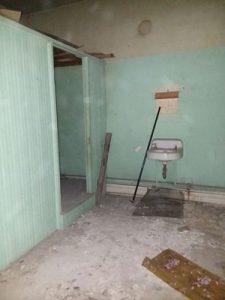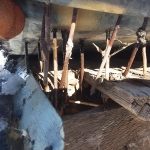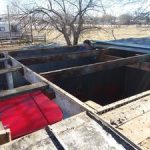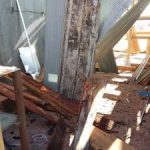The Job: Apartments above Florence Lanes.
Decades of neglect left the building with a compromised roof and water damage. The new owners, the Duncan family, contacted us to salvage the building since they were getting ready to gut everything and move forward with the planned remodel.In this salvage job we removed most doors, interior windows, all hardware and some sinks. We plan to go back for some more bathroom fixtures.





The Building: W.P. Wilbar Block 108-110 W. Main
The building was erected in two sections in 1895(east) and 1896 (west). The brick of the eastern part is a slightly lighter shade than the west part.
 In 1895 the eastern portion of the building housed the grocery of William Pawton Wilbar who was described as “a pioneer of the community who had taken an active part in its business and community life.” In 1917, he sold his business in Florence and took a management position with the Portland Mercantile Company.
In 1895 the eastern portion of the building housed the grocery of William Pawton Wilbar who was described as “a pioneer of the community who had taken an active part in its business and community life.” In 1917, he sold his business in Florence and took a management position with the Portland Mercantile Company.
Wilbar was known as “the father of Newlan Creek” because he was the principal of getting the creek’s mountain water for the city’s water supply. He died in Florence in 1945.
Fremont Lanes bowling alley has been at this location since 1960. The bowling alley was associated with Fremont Lanes café. At that time, the bowling alley offered eight lanes, a pro shop, and a lounge and snack bar. With a modern rehab before it opened, it was their liquor license that moved the City into a new era, as the 1st liquor license sold in Florence, for use on the established “safe side” for women and children to pass on North side of Main Street. Up to this time, all liquor sales were on the south side of Main Street.
The Future: Lofts
In 2019, Roger and Kathryn Duncan purchased the Florence Lanes Bowling Alley. The original bowling Alley was built in 1960 and will be 60 years old this year.
The Duncan’s plan on modernizing it while at same time preserving its history by putting back in the original 1958 Brunswick Bowling masking units which have been stored in the basement since the mid 1970’s. They also have plenty of bowling memorabilia that was stored in the basement that will be used to create a timeline of the bowling alley.
Upstairs above the Bowling Alley they plan on building 5 residential lofts that will be for sale and that also keep some of the buildings history while also making them updated and convenient for today’s resident. It will provide downtown living and walkability to Florence’s many restaurants, Shops etc.



















